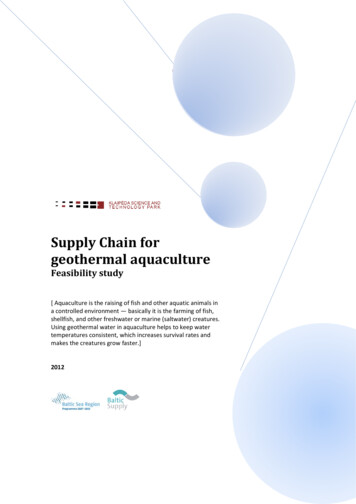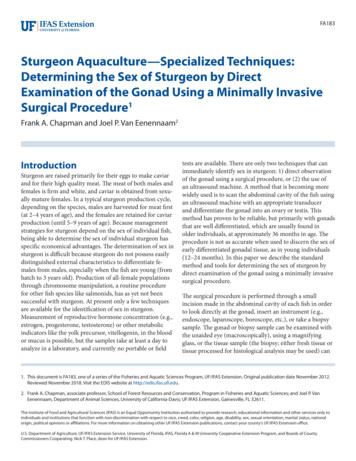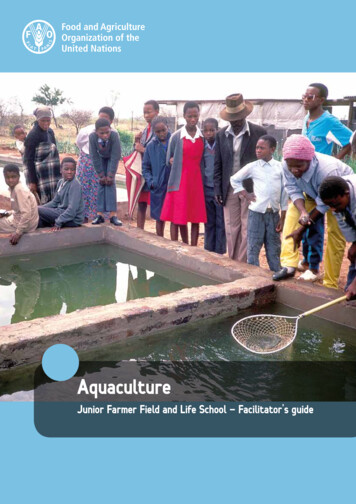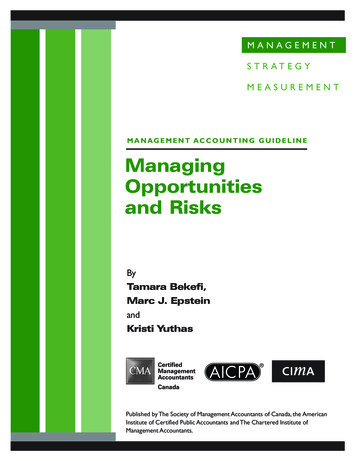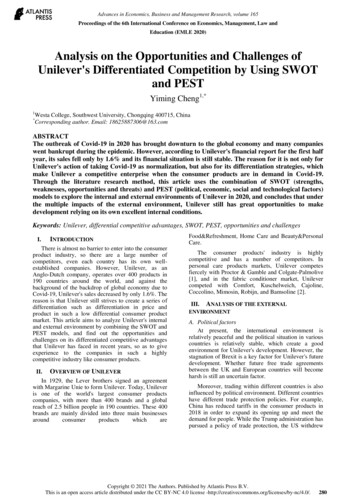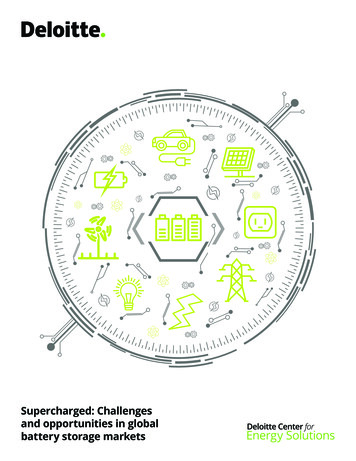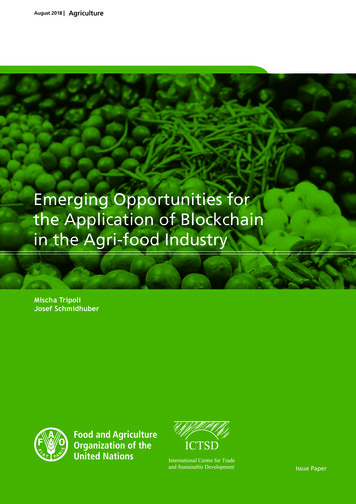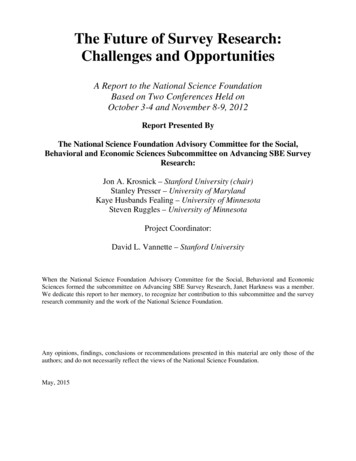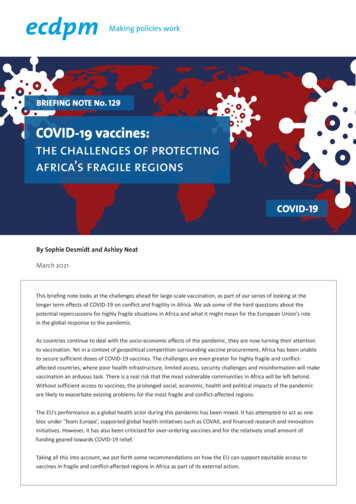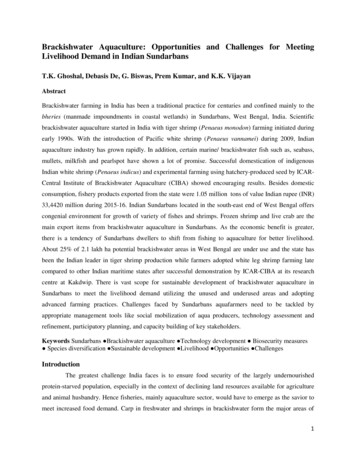
Transcription
Brackishwater Aquaculture: Opportunities and Challenges for MeetingLivelihood Demand in Indian SundarbansT.K. Ghoshal, Debasis De, G. Biswas, Prem Kumar, and K.K. VijayanAbstractBrackishwater farming in India has been a traditional practice for centuries and confined mainly to thebheries (manmade impoundments in coastal wetlands) in Sundarbans, West Bengal, India. Scientificbrackishwater aquaculture started in India with tiger shrimp (Penaeus monodon) farming initiated duringearly 1990s. With the introduction of Pacific white shrimp (Penaeus vannamei) during 2009, Indianaquaculture industry has grown rapidly. In addition, certain marine/ brackishwater fish such as, seabass,mullets, milkfish and pearlspot have shown a lot of promise. Successful domestication of indigenousIndian white shrimp (Penaeus indicus) and experimental farming using hatchery-produced seed by ICARCentral Institute of Brackishwater Aquaculture (CIBA) showed encouraging results. Besides domesticconsumption, fishery products exported from the state were 1.05 million tons of value Indian rupee (INR)33,4420 million during 2015-16. Indian Sundarbans located in the south-east end of West Bengal offerscongenial environment for growth of variety of fishes and shrimps. Frozen shrimp and live crab are themain export items from brackishwater aquaculture in Sundarbans. As the economic benefit is greater,there is a tendency of Sundarbans dwellers to shift from fishing to aquaculture for better livelihood.About 25% of 2.1 lakh ha potential brackishwater areas in West Bengal are under use and the state hasbeen the Indian leader in tiger shrimp production while farmers adopted white leg shrimp farming latecompared to other Indian maritime states after successful demonstration by ICAR-CIBA at its researchcentre at Kakdwip. There is vast scope for sustainable development of brackishwater aquaculture inSundarbans to meet the livelihood demand utilizing the unused and underused areas and adoptingadvanced farming practices. Challenges faced by Sundarbans aquafarmers need to be tackled byappropriate management tools like social mobilization of aqua producers, technology assessment andrefinement, participatory planning, and capacity building of key stakeholders.Keywords Sundarbans Brackishwater aquaculture Technology development Biosecurity measures Species diversification Sustainable development Livelihood Opportunities ChallengesIntroductionThe greatest challenge India faces is to ensure food security of the largely undernourishedprotein-starved population, especially in the context of declining land resources available for agricultureand animal husbandry. Hence fisheries, mainly aquaculture sector, would have to emerge as the savior tomeet increased food demand. Carp in freshwater and shrimps in brackishwater form the major areas of1
activity in Indian aquaculture. Brackishwater farming in India is an age-old traditional system confinedmainly to the bheries (manmade impoundments in coastal wetlands) of West Bengal, similar to gheris inOdisha, pokkali’ (salt resistant deep water paddy) fields in Kerala, kharlands in Karnataka andMaharashtra, and khazans in Goa coasts (Alagarswami 1981). These systems have been sustainingproduction of 500–750 kg ha-1 year-1 with shrimp contributing 20–25% without additional input, exceptthat of trapping the naturally bred juvenile fish and shrimp seed during tidal influx (FAO 2014).Scientific farm management in brackishwater sector in India initiated during early 1990sconcentrated around the giant tiger shrimp (Penaeus monodon), which witnessed a phenomenal increaseduring 1990–1994, and the bust came in 1995-96 with the outbreak of viral disease. Later, with the adventof bio-secured closed culture technology (Panigrahi et al 2009) using better management practices, semiintensive shrimp farming started to regain its lost glory during early years of last decade. Apart from thegiant tiger shrimp, certain marine/ brackishwater fishes such as seabass, mullets, milkfish, catfish andpearlspot have shown a lot of promise for commercial aquaculture. Since 2009, the culture of exoticwhite-leg shrimp, Penaeus vannamei, has attracted the farmers’ attention because of its fast growth, lowincidence of native diseases, availability of Specific Pathogen Free (SPF) domesticated strains, andculture feasibility in wide salinity range. Recently, ICAR-Central Institute of Brackishwater Aquaculture(CIBA) has been successful in domestication of indigenous Indian white shrimp, Penaeus indicus, andexperimental farming using hatchery-produced seed showed promising result. Seabass farming waspopularized by ICAR-CIBA through culture demonstration of seabass in different coastal states of India.India produced 4.88 million tons of aquatic animals through aquaculture during 2014, ranking second inthe world only after China, while total fisheries production was 9.6 million tons (FAO 2016).Indian Sundarbans located in the lower Gangetic region of the sub-continent at the apex of Bay ofBengal (within latitude 21 13' N to 22 40' N and longitude 88 03' E to 89 07' E), covering little less thanhalf of the total Sundarbans, offers a congenial environment in terms of salinity and other hydrologicalparameters for the growth and culture of variety of fishes. This region is intersected by a complexnetwork of tidal waterways, mudflats, and small islands of salt-tolerant mangrove forests, and presents anexcellent example of ongoing ecological processes, which is vulnerable to environmental alterations. Inthis coastal region, there are a large number of poor marine fishermen who primarily depend on theHooghly-Matla estuarine complex and the adjacent sea for their livelihood. As the economic benefit isgreater than that in traditional fishing, there is a tendency to shift from fishing to aquaculture. In tune withthe Indian trend, aquafarmers of Indian Sundarbans has adopted scientific brackishwater farming withremarkable success which has become an important tool for increasing livelihood security in such avulnerable eco-region. There is vast scope for sustainable development of brackishwater aquaculture in2
Sundarbans to meet the livelihood demand utilizing the unused and underused areas and adoptingadvanced farming practices. Challenges faced by Sundarbans aquafarmers need to be tackled byappropriate management tools like social mobilization of aqua producers, technology assessment andrefinement, participatory planning, and capacity building of key stakeholders, which are being discussedin this article.Area, Production and ProductivityIn India, about 13% of 1.24 million ha potential brackishwater resource is under use at present.Farmed tiger shrimp production recorded over five-fold increase from 28000 tons in 1988-89 to 144347tons utilizing 149632 ha in 2006-2007 (MPEDA 2017), and was operating at around 100000 tons tigershrimp till introduction of white leg shrimp during 2009. Afterwards, a shift towards white leg shrimpfrom tiger shrimp was observed over recent years (Fig. 1). In this process, tiger shrimp production wasreduced to 81450 tons utilizing 68846 ha with productivity of 1.18 tons ha-1year-1, while production ofwhite leg shrimp reached all-time high of 406018 tons utilizing area of 59116 ha with productivity of 6.87tons ha-1year-1 during 2015-16 (MPEDA 2017).Total fish production in West Bengal during 2015-16 was 1.67 million tons of which 0.12 millionton was contributed by shrimp (DoFWB 2016). West Bengal being the largest producer of tiger shrimpamong Indian maritime states produced 61998 tons of tiger shrimp utilizing 50593 ha during 2015-16,and majority of this was produced in Indian Sundarbans covering two maritime districts (South and North24 Parganas) occupying most of the 0.21 million ha potential brackishwater areas in the state. The age-oldtraditional farming methods of shrimp and finfish with some modification still exist because of theirsimplicity and cheapness. A part of these are being gradually replaced by modern improved culturepractices.Brackishwater farmers of West Bengal started adopting white leg shrimp farming late comparedto other Indian maritime states. First, white leg shrimp farming demonstration in West Bengal was carriedout by ICAR-CIBA, Kakdwip Research Centre, Kakdwip during 2012, and farmers started to adopt itsfarming since 2013 replacing tiger shrimp. White leg shrimp production in West Bengal during 2015-16was 6776 tons utilizing 1387 ha area with productivity of 4.88 tons ha-1 year-1. A comparative trend oftiger shrimp and white leg shrimp production in West Bengal is presented in Fig. 2.Contribution of the Sector to the Indian EconomyIndia has shown continuous and sustained increments in fish production since independence.Constituting about 6.3% of the global fish production, the sector contributes 1.1% of the GDP and 5.15%of the agricultural GDP of India. The total fish production of 10.07 million metric tons during 2015-163
had nearly 65% contribution from the inland sector of which major share came from culture fisheries(NFDB 2017). There are 429 Fish Farmers Development Agencies (FFDAs) and 39 Brackishwater FishFarmers Development Agencies (BFDAs) in India for promoting freshwater and coastal aquaculture. Theannual carp seed production is to the tune of 25 billion and that of shrimp about 12 billion, withincreasing diversification in the recent past. Fish and fish products have presently emerged as the largestgroup in agricultural exports of India with 1.05 million tons in term of quantity and INR 33,4420 millionin value during 2015-16. This accounts for around 10% of the total exports of the country and nearly 20%of the agricultural exports. More than 50 different types of fish and shellfish products are exported to 75countries around the world (NFDB 2017).Fisheries sector of West Bengal contributed 2.35% of Net State Domestic Products (NSDP)during 2014-15 which is much higher than contribution of the sector in Indian GDP indicating itsimportance to the state’s economy (DoFWB 2016). Besides domestic consumption, fishery productsexported from the state was 91263 tons of value Rs. 34390 million during 2015-16. Frozen shrimp andlive crab are the main export items from brackishwater aquaculture in Sundarbans.Advances in Brackishwater Aquaculture TechnologiesThere are five different brackishwater aquaculture practices mentioned in the literature, rangingfrom traditional to super-intensive (Shiva and Karir 1997, Primavera 1998, Rosenberry 1999). Mostcommon practices followed in Sundarbans are traditional, extensive, semi-intensive, and intensive. Theseare divided according to stocking densities and the extent of management, i.e. level of inputs (Table. 1),which turns out into different economic outcomes (Table. 2).Traditional systems are often characterised by polyculture of shrimp and fish or by rotation withrice. In this method, low-lying areas near the banks of saline water rivers and creeks are encircled byperipheral dyke, and tidal water is allowed to enter into the impoundment along with natural seeds ofvarious species of shrimps, crabs and fishes. Water is retained with periodical exchanges during lunarcycles and the animals are allowed to grow utilizing natural food. After 3 – 4 months, partial harvestingstarts using tidal inflow during lunar cycles and continues up to 10 – 11 months. Productivity in thissystem ranged between 500 – 750 kg ha-1year-1 of which about 30 percent is constituted by prawns/shrimps and 70 per cent by other brackishwater fishes.The extensive farming is commonly known as improved traditional farming, which relies on thetides to provide most of the food for the shrimp and as a means of water exchange. Feed for shrimp isnaturally occurring, and in some cases fertilizers or manure is added to promote algal growth. Lowstocking densities result in modest yields. This system involves construction of peripheral canals/ ponds4
of size ranging from 1 – 5 ha. Shrimp seed at the rate of 15000 – 20 000 per ha are stocked. The averageyield is 1500 – 1700 kg ha-1, including finfishes. Supplementary feeding is not generally practised;however, some farmers use oilcakes and rice bran as supplementary feed.Semi-intensive cultivation involves stocking densities beyond those that the natural environmentcan sustain without additional inputs. Consequently, these systems depend on reliable shrimp post larvae(PL) supply and greater management intervention compared to extensive ponds. With stocking rates of 620 shrimp PL per m2, fertilizers are applied to augment natural food in the ponds. Supplementary feedingis done using formulated feeds preferably in pelletized form. Maximum annual yields range from 2 to 6tons per hectare. The risk of crop failure increases with increasing farming intensity, which is mainly dueto the impact on water quality exerted by the high stocking densities and supplementary feeding. Thehigher the culture intensity, the higher the capital required, and higher the risks involved. Thus, theincreased capital inputs required for semi-intensive culture often preclude its adoption by small-scaleproducers. Most of the tiger shrimp monoculture is carried out in this system.Intensive grow-out systems utilize ample supplies of clean sea/ estuarine water, adequateinfrastructure, and well-developed hatchery and feed industries. Intensive shrimp farming introducessmall enclosures (down to 0.1 ha), high stocking densities (20-50 hatchery-produced shrimps per m2),around-the-clock management, very high inputs of formulated feeds, and aeration. Yields range from 7 to15 tons ha-1year-1 with high risk of crop failure due to diseases. Most of the P. vannamei farming isconducted in this method using specific pathogen free (SPF) seeds under strict biosecurity protocol.Scientific Shrimp Farming Practices Followed in Indian SundarbansSite SelectionThe site is selected only after thorough analysis of information on topography, ecosystem,meteorological, socioeconomic conditions, and economic viability. Coastal sites with gentle slopestowards the sea are selected requiring less financial inputs. Clay loam or silty clay loam soil is preferred(CIBA 2004). Site should be easily accessible with availability of basic needs and not within coastalregulation zone (CRZ) following Coastal Aquaculture Authority of India (CAA) guidelines.Farm Design and ConstructionProper designing and construction of farms are essential for efficient management and forpromoting environmental protection. A typical shrimp farm is shown in Picture. 1. The height ofperipheral dyke is built in accordance with highest flood level. Height of the pond dyke should be at least2 m with side slope of 1:1 for clayey soil and 3:1 for sandy soil (CIBA 2004). Rectangular or square5
ponds are appropriate. A reservoir pond is required to act as settlement pond. Effluent treatment pond(ETP) becomes an essential part of a semi-intensive farm.Pond PreparationGood pond preparation is the key to reduce disease risks and improving shrimp production.Presence of black soil in pond bottom is checked in wet condition. Black soil may be removed eitherusing mud pumps in wet condition or manual labor after drying. Optimum average soil pH should be 6.57.5. Lower soil pH may be corrected applying lime. Soon after pH correction, ponds are filled withoptimum quality water up to a depth of 120-150 cm after screening through 60-80 mesh net. Water isretained for 3 days with aeration for 1-3 hours daily. Aerators are positioned properly to achievemaximum water circulation. Every 500 kg production beyond 2000 kg ha-1 requires minimum 1 KWaeration power (Boyd 1998). Pond is disinfected by applying bleaching powder @ 60 ppm (20 ppmchlorine) during late evening. After 5 days, dolomite @ 100-200 kg ha-1 and organic juice @ 200 litre ha-1on the following day are applied to stimulate plankton bloom. This schedule is repeated three times at agap of 3 days. Organic juice is prepared by mixing 60 kg paddy flour, 20 kg molasses and 3 kg yeast in200 L freshwater ha-1, and incubated for 48 hours in air tight condition (Panigrahi et al 2009). When thecolor of the water is green, fluctuation between morning (6:00 AM) and late afternoon (3:00 PM) pH isbelow 0.5 and other parameters in optimum range, the pond is ready for stocking.Biosecurity MeasuresBiosecurity measures are of immense importance in shrimp farming to protect the stock fromdiseases. Farm should be protected with bird and crab fencing (CIBA 2010a). A typical biosecuredshrimp pond is shown in Picture. 2. Proper hand and foot wash in potassium permanganate solution ismandatory before entering the farm. Every pond should have separate implements. Water depth more than120 cm in the pond reduces stress and risks of diseases. Farming in closed ponds i.e., ‘0 exchange’restricts entry of pathogen and carriers of diseases. All implements are washed in chlorinated water beforefirst use. Proper understanding of the personals on biosecurity measures is most important.StockingSelection of good quality PL for stocking is an important criterion. Good quality seeds arecharacterized by uniform size, intact appendages, healthy appearance and active movement. Further,seeds which tested negative for monodon baculo virus (MBV) and white spot syndrome virus (WSSV)are stocked. Stocking is done during early morning or late evening after proper acclimatization to pondwater condition. Recommended stocking density is up to 30 number per m2 for specific pathogen free(SPF) P. monodon (CAA 2012) and up to 60 numbers per m2 for P. vannamei (CAA 2009).6
Feeding ManagementFeed accounts for about 60% of total operational expenditure. Both over-feeding and underfeeding may result in crop loss. Feed should contain appropriate nutrients for the particular species andshould be of appropriate crumble or pellet size as per size of shrimp. Feed should be stored in dry andaerated place. Daily ration is divided into meals and applied as per Tables. 3 and 4. Daily ration iscalculated as per Tables. 5 and 6. Blind feeding is practised up to 50 days and feed requirementafterwards is calculated based on estimated biomass through sampling and using the formula(Chanratchakool et al 1994):𝐷𝑎𝑖𝑙𝑦 𝑟𝑎𝑡𝑖𝑜𝑛 (𝑘𝑔) 𝑀𝑒𝑎𝑛 𝑏𝑜𝑑𝑦 𝑤𝑒𝑖𝑔ℎ𝑡 (𝑔) 𝑆𝑡𝑜𝑐𝑘𝑖𝑛𝑔 𝑛𝑜 𝐴𝑠𝑠𝑢𝑚𝑒𝑑 𝑠𝑢𝑟𝑣𝑖𝑣𝑎𝑙 (%) 𝐹𝑒𝑒𝑑𝑖𝑛𝑔 𝑟𝑎𝑡𝑒 (𝑎𝑠 % 𝑜𝑓 𝑏𝑖𝑜𝑚𝑎𝑠𝑠)10000 1000For example, daily feed requirement for 100000 tiger shrimp of 5 g average body weight with assumedsurvival of 90% using Table. 5 would be:5 100000 90 5.5 24.75 𝑘𝑔10000 1000Six check trays (80 80 10 cm) per ha are placed on the pond floor just beyond the dyke slopesand a small part of the calculated meal is placed in trays during feeding. Check trays are monitored after 2hours of feed application. If some feed is left in trays, feed is reduced by 10-20%; when feed is fullyconsumed within 2 hours, increment of 10-20% in the next meal is done. Quantity of feed in check traysvaries with pond size and can be calculated from recommended ‘feed in each check tray (g kg-1)’ providedin Tables. 5 and 6 for respective species using the formula:𝑄𝑢𝑎𝑛𝑡𝑖𝑡𝑦 𝑜𝑓 𝑓𝑒𝑒𝑑 𝑖𝑛 𝑒𝑎𝑐ℎ 𝑐ℎ𝑒𝑐𝑘 𝑡𝑟𝑎𝑦 (𝑔) 1600 𝐹𝑒𝑒𝑑 𝑖𝑛 𝑒𝑎𝑐ℎ 𝑐ℎ𝑒𝑐𝑘 𝑡𝑟𝑎𝑦 (𝑔 𝐾𝑔) 𝑄𝑢𝑎𝑛𝑡𝑖𝑡𝑦 𝑜𝑓 𝑚𝑒𝑎𝑙 (𝐾𝑔)𝐴𝑟𝑒𝑎 𝑜𝑓 𝑝𝑜𝑛𝑑For example, feed quantity in each check tray for each kg of meal for tiger shrimp of 5 g averagebody weight (Table. 5) in different pond sizes would be:𝐶ℎ𝑒𝑐𝑘 𝑡𝑟𝑎𝑦 𝑓𝑒𝑒𝑑 𝑞𝑢𝑎𝑛𝑡𝑖𝑡𝑦 𝑜𝑟 𝑒𝑎𝑐ℎ 𝑘𝑔 𝑜𝑓 𝑚𝑒𝑎𝑙 𝑖𝑛 1000 𝑠𝑞 𝑚 𝑝𝑜𝑛𝑑 1600 24 1 38.4 𝑔1000𝐶ℎ𝑒𝑐𝑘 𝑡𝑟𝑎𝑦 𝑓𝑒𝑒𝑑 𝑞𝑢𝑎𝑛𝑡𝑖𝑡𝑦 𝑓𝑜𝑟 𝑒𝑎𝑐ℎ 𝑘𝑔 𝑜𝑓 𝑚𝑒𝑎𝑙 𝑖𝑛 2000 𝑠𝑞 𝑚 𝑝𝑜𝑛𝑑 1600 24 1 19.2 𝑔2000Water Quality Management7
Maintaining optimum water quality (Table. 7) is very important to minimize stress and diseaserisks, and to finally achieve better shrimp production. Liming is most important in water and soil qualitymanagement. Water pH should range from 7.5 to 8.5 with diurnal fluctuation less than 0.5. Dissolvedoxygen (DO) should not be allowed to drop below 4 ppm at any time (CIBA 2010b). Aeration is donebefore each feeding. Organic juice is applied fortnightly to maintain C: N ratio in the pond. Commerciallyavailable probiotics are also used.Mineral supplementation is required for P. vannamei at low salinity and in areas with mineraldeficiency in soil. Mineral concentrations at a particular salinity should be equivalent to that of seawaterdiluted to that salinity (CIBA 2016). Mineral concentrations of seawater and factors for 1 ppt salinity arepresented in Table. 8.For example, concentration of calcium at 4 ppt should be 46.4 (4 11.6) mg/ LMineral requirement is calculated by using the following formula:𝑀𝑖𝑛𝑒𝑟𝑎𝑙 𝑠𝑎𝑙𝑡 𝑟𝑒𝑞𝑢𝑖𝑟𝑒𝑚𝑒𝑛𝑡 (𝑔 𝑚3 ) �� 𝑜𝑓 𝑚𝑖𝑛𝑒𝑟𝑎𝑙 𝑖𝑛 𝑤𝑎𝑡𝑒𝑟 (𝑚𝑔 𝐿) 0.1𝑃𝑒𝑟𝑐𝑒𝑛𝑡𝑎𝑔𝑒 𝑜𝑓 𝑡ℎ𝑒 𝑚𝑖𝑛𝑒𝑟𝑎𝑙 𝑖𝑛 𝑠𝑎𝑙𝑡Diversified Aquaculture Practices Recommended for SundarbansIn recent years, successful farming demonstrations of finfishes have paved the way forcommercial farming expansion in brackishwater sector in West Bengal. Asian seabass, grey mullet andpearlspot are presently under farming in the state. Milkfish farming has been initiated recently withremarkable success.Asian SeabassCannibalism being one of the most serious problems, Asian Seabass (Lates calcarifer) farming isdone in two phases viz., nursery and grow-out. Nursery pond size ranges from 500 to 2000 m2 with waterdepth of 50-80 cm. A well-prepared pond is important as predators and competitors can endanger thestocked fry. Fry ranging from 1 to 2.5 cm are stocked @ 20-50 individuals m-2. Fry are fed with choppedand grounded (4-6 mm3) trash fish at 100% of biomass initially and gradually reduced to 10% at the endin two equal meals during 9:00 AM and 5:00 PM. The nursing period lasts for about 30-45 days untilfingerling stage (5-10 cm) is reached. Hapa, a net cage (mesh size 1.5-2 mm) having dimension of 2 1 1m, is used for nursery rearing of seabass fry in pond, where 200-300 fry are stocked in series of hapas andfed with finely chopped trash fish in same way as in ponds. Fry in hapa rearing system can be fed withmarine fish larval diet at three times a day (Biswas et al 2010). Fishes are graded in different size groupsat 5-7 day intervals and restocked in thoroughly cleaned and sundried hapas. Better survival is achieved inhapa nursery rearing than in pond. For production of fingerlings, hapa is an ideal system for nursery8
rearing of seabass (Prem et al 2016). As cannibalism and differential growth are major problems inseabass nursery, supplementation of 0.5% of L-tryptophan in larval diet reduces cannibalism andimproves survival of seabass fry (Prem et al 2017a).The grow-out phase lasts for about 8-12 months. There are two culture systems employed in pondgrow-out of seabass:(i)The supplementary feeding system is followed in places with adequate supply of fresh trash fishat low-cost. Fingerlings are stocked @ 10000-20000 ha-1. Chopped trash fish is fed twice daily inthe morning at 8:00 AM and afternoon at 5:00 PM at 10% of biomass initially and graduallyreduced to 5% at the end. A very recent development on improving the dietary intake of seabassis the introduction of moist feed. A production of 2-3 tons per ha can be achieved in 8-12 months.(ii)Forage fish feeding system shows great promise. Abundant natural food is produced and selectedtilapia brood stocks are released in the pond at the rate of 5000-10000 ha-1. Sex ratio of male tofemale is 1:3. Tilapia is reared in pond for 1 to 2 months or until tilapia fry appear in sufficientnumber. Seabass juveniles (8-10 cm in size) from nursery are stocked at the rate of 10000-20000per ha. Fertilization is continued to maintain tilapia seed production. Seabass production of 2-3tons ha-1 and tilapia production of 1-2 tons ha-1 is achieved in 8-12 months (Biswas et al 2011a).Grey MulletFull-scale commercial production of grey mullet (Mugil cephalus) is a new area of aquaculturediversification in India. This is done in two phases, namely nursery rearing and grow-out culture. Aftercollection from natural sources, fry are transported in oxygen packs at a density of 240 fry L-1 for longdistance (Prem et al 2012). After acclimatization, fry are stocked in well-prepared earthen nurseries athigh densities (up to 25 m-²), where they depend mainly on natural food in fertilized ponds (Biswas et al2012). Moreover, periphyton-based seed rearing is a better option compared to complete feed-basedsystem (Biswas et al 2017). Rice or wheat bran is sometimes used as an additional source of food. Fry arekept in the nursery ponds for 4–6 months (from January-February till June-July) until they are about 20 30 g in weight. The fingerlings are then caught, either by draining the nursery ponds into catch ponds orby netting. Grey mullets are usually grown in monoculture or polyculture ponds. Prior to stocking, pondsare prepared by drying, ploughing, and manuring with 2.5–5.0 tons cowdung per ha. Ponds are then filledto a depth of 25–30 cm and kept at that level for 7–10 days to build up a suitable level of natural feed. Thewater level is then increased to 1.5–1.75 m and fingerlings are stocked @ 1-2 m-2. Extruded feed issupplied to semi-intensive ponds at 5% of biomass initially and gradually reduced to 1% at the end.The growing season is normally about 7–8 months. A production of 2.3-3.7 tons ha-1 can be achieved. In9
polyculture, they are usually stocked with tilapia, milkfish and pearlspot in brackishwater, and withcommon carp and silver carp in freshwater. In this case, feeding and fertilization programmes are usuallytargeting the other cultured species, and the mullet feed on the natural feed, detritus, and feed leftovers.Acclimatized to the appropriate salinity, and stocked as 10–15 g individuals at 0.6–0.7 m-2, a harvest of4.3–5.6 tons ha-1 crop-1 can be obtained.PearlspotPearlspot (Etroplus suratensis), also known as ‘green chromide’, is cultured in the state of Keralain traditional manner in the Pokkali fields. Farming of this species is practised in West Bengal in a smallscale. This fish is highly adapted to captive farming due to its ability to feed on a variety of natural foods.Pearlspot can spawn many times during a prolonged breeding season. Environment simulation, ratherthan hormonal manipulation, is employed for inducing captive breeding of pearlspot. Captive breeding iscarried out either in ponds, tank and cage systems provided with artificial substrates and breeding pits.Appropriate water levels and moderate water flow trigger captive breeding in tank system. Around 400–2000 eggs are laid per brood and over 90% survival is generally obtained. Tank based breeding is alsopossible for captive seed production (Biswas et al 2014). Nursery rearing is done in small earthen pondsand tank system (Biswas et al 2013). Ponds are sun-dried and limed before letting in water. Water is takenthrough fine mesh filters to avoid entry of predators. Organic fertilizer is applied @ 500 – 1000 kg ha-1 toboost up plankton bloom. After achievement of sufficient plankton bloom fry of 1 – 1.5 cm size arestocked @ 5 – 10 no. m-2. Fishes are fed with mixture of rice bran and mustard oil cake (3:1) in finepowder form at 20% of biomass initially and gradually reduced to 5% at the end. After two months, fishesattain a length of 5 – 10 cm depending on availability of natural food in the nursery ponds. Most of themare harvested to be sold as ornamental fish. Grow-out monoculture is done in similar way with 2 – 5 no.m-2 and feeding is done at 5% of biomass initially and gradually reduced to 2% at the end for 6 - 8months. Fishes attain an average body weight of about 100 g in this practice.MilkfishMilkfish (Chanos chanos) is a highly potential candidate species for brackishwater aquaculturebecause of its fast growth, efficient use of natural food, disease resistance, and readiness to accept varietyof supplementary feeds. It constitutes important seafood in Southeast Asia and some Pacific Islands. It iscalled ‘bangus’ in the Philippines, where it is the national fish. In India, extensive seed availability isobserved in south-east and south-west coast during April-June and October-December. Seeds arecollected from those areas and reared in saline impoundments. Recently, success in captive breeding hasbeen achieved by ICAR-CIBA. Nursery rearing is carried out in small earthen ponds. Fry are stocked @10-25 m-2 and fed with 1: 1 mixture of oil cake and rice bran as supplementary feeding at 20% of biomass10
initially and gradually reduced to 6% at the end. Fishes attain 10- 30 g in 2-3 months nursery rearing.Pond grow-out is mainly done depending on natural food with low production ranging between 1 to 2tons ha-1year-1 (Biswas et al 2011b). Recent culture trials in Sundarbans by Kakdwip Research Centre(KRC) of ICAR-CIBA at stocking density of 1 fish m-2 and feeding with formulated floating pellet feed(crude protein: 24%, crude fat: 4%) @ 2-6 % of fish biomass in non-aerated periphyton supportedbrackishwater pond, and has achieved production of more than 4 tons ha-1 in 8 months. Fishes grew to400-500 g during 8 months rearing period registering over 90% survival. This fish is a good candidatespecies for polyculture with shrimp as it has stronger mucosal immune properties compared to that ofmullet and seabass (Prem et al 2017b) and may help in disease prevention.Opportunities, Challenges and ConflictsOpportunitiesThere are different opportunities to improve brackishwater aquaculture production. Among shortterm strategies, improving traditional system of farming, development and dissemination of low-costfarm-made feed, control of diseases, and improved production through good aquaculture practices like,biofloc and periphyton based system, are the best options available. Long-term strategies like,development of organic farming, genetic improvement of shrimp stock through selective breeding,improved and intensive culture methods, adoption of cage farming of fishes, and overcoming theconstrains
farming since 2013 replacing tiger shrimp. White leg shrimp production in West Bengal during 2015-16 was 6776 tons utilizing 1387 ha area with productivity of 4.88 tons -ha-1 year 1. A comparative trend of tiger shrimp and white leg shrimp production in West Bengal is presented in
